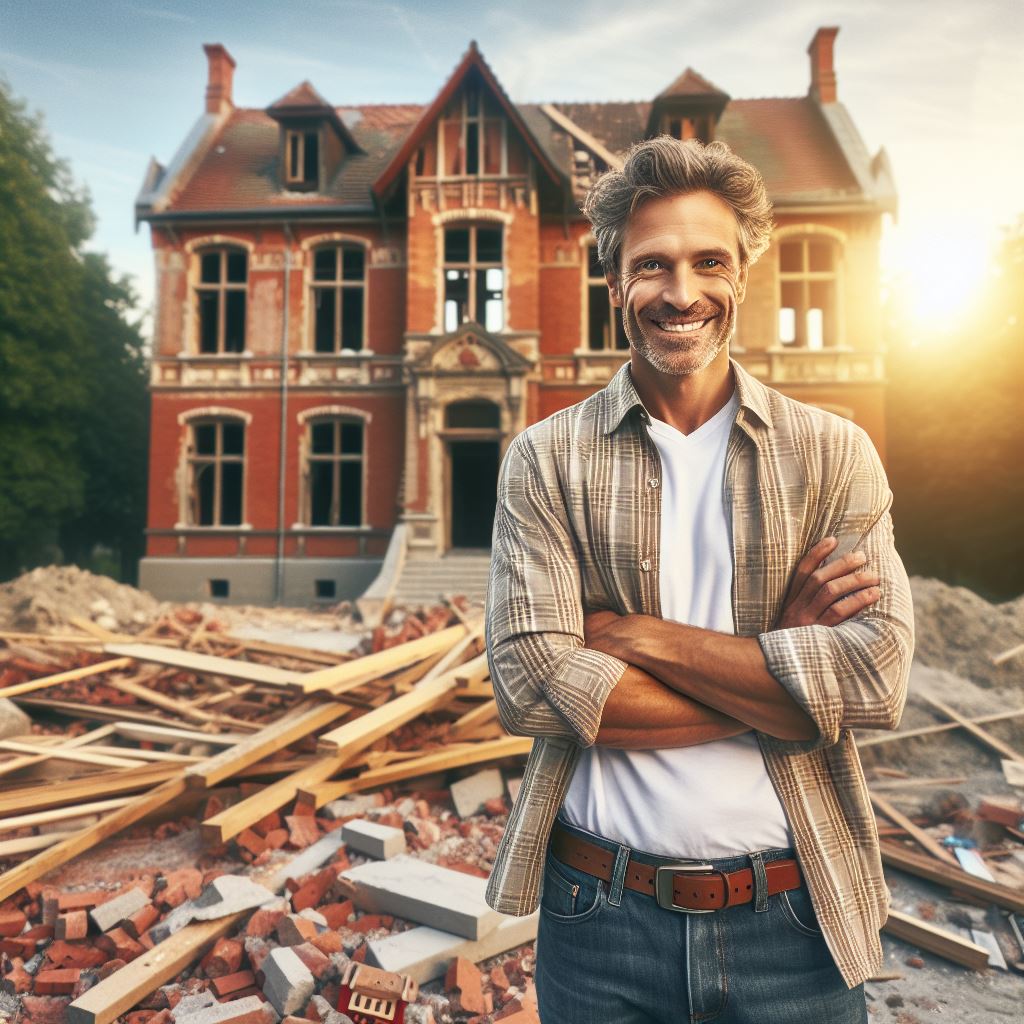Introduction
Historic Building Makeover: In the bustling heart of the city, where the past meets the present, historic buildings stand as silent witnesses to the passage of time.
Imagine unlocking the untapped potential of these architectural gems, transforming them from relics of the past into thriving hubs of modern prosperity.
The journey to a Historic Building Profitable Makeover is more than a restoration; it’s a renaissance.
Picture this: the echo of history reverberating in the walls, now infused with the vibrancy of commerce and community. This is the story of turning yesterday into tomorrow.
The preservation and revitalization of historic buildings have gained momentum in recent years, not just as a nod to nostalgia but as a savvy business venture.
The symbiosis between preserving the architectural heritage and fostering economic growth has sparked a trend that transcends mere restoration.
This movement is a testament to the fact that history can be both a guide and a catalyst for progress.
By breathing new life into these structures, we not only preserve our cultural roots but also create thriving spaces that contribute to the economic landscape.
The Historic Building Profitable Makeover is not just a marriage of history and commerce; it’s a testament to the adaptive resilience of our urban spaces.
This post delves into the art of transforming historic buildings into profitable ventures, exploring the delicate balance between preserving the soul of the past and embracing the demands of the present.
Through innovative strategies, community engagement, and a keen understanding of market dynamics, we’ll unravel the blueprint for success in this unique venture.
So, let’s embark on a journey where time-honored structures become not only guardians of history but also pioneers of a prosperous future.
Importance of renovating historic buildings
Preserving our cultural heritage is not merely a nostalgic pursuit; it’s an investment in our identity and a nod to the richness of our past.
When it comes to historic buildings, a profitable makeover isn’t just about turning a profit; it’s about revitalizing the soul of a community.
Preservation of Cultural Heritage
Historic buildings are like pages in a living history book, narrating tales of a bygone era.
Renovating these structures is akin to restoring a section of our collective story.
The intricate details, the craftsmanship of another time – these are the threads that weave the fabric of our cultural identity.
By refurbishing historic buildings, we ensure that the narrative of our past remains intact for generations to come.
It’s not just about bricks and mortar; it’s about safeguarding the spirit of our forefathers.
Attractiveness for Tourists
Tourists don’t merely seek destinations; they crave experiences that transport them to another time.
Historic buildings, with their storied pasts and architectural marvels, become magnets for travelers.
Renovating these structures enhances their allure, creating a symbiotic relationship between preserving heritage and attracting tourism.
Tourists become patrons of history, injecting life – and funds – into communities that honor their past.
The economic ripple effect is profound, transforming historic districts into vibrant, bustling hubs.
Unique Architectural Features
Historic buildings are often repositories of unique architectural features that are seldom replicated in modern construction.
From ornate cornices to stained glass windows, these elements are a testament to the craftsmanship of yesteryears.
Renovating these structures not only preserves these distinctive features but also provides an opportunity to showcase them.
The charm lies in the details – the hand-carved embellishments, the intricate ironwork – elements that stand as a testament to an era when aesthetics met functionality.
In fact, the importance of renovating historic buildings goes beyond a mere facelift.
It’s a commitment to preserving our roots, an invitation for tourists to step into a living history, and an acknowledgment of the irreplaceable architectural gems that grace our landscapes.
A profitable makeover, in this context, becomes a harmonious blend of commerce and culture, ensuring that the past remains an integral part of our present and future.
Read: Climate Change & Commercial Property Impact
Challenges of renovating historic buildings
Renovating historic buildings can be a rewarding venture, blending the charm of the past with modern functionality.
However, this endeavor is not without its challenges.
Understanding and overcoming these hurdles is crucial for a successful and profitable makeover.
Structural Issues
Historic buildings often come with a unique set of structural challenges.
The passage of time may have taken a toll on the foundation, walls, and overall stability of the structure.
Dealing with outdated construction materials and methods poses a significant obstacle.
Renovators must carefully assess the structural integrity, identifying weaknesses that require reinforcement without compromising the historical essence.
Collaborating with structural engineers becomes imperative to strike a balance between preservation and safety.
Cost of Renovation
One of the foremost challenges in historic building makeovers is the considerable cost associated with renovations.
Preserving historical elements, sourcing authentic materials, and adhering to strict restoration standards can escalate expenses.
Investors must carefully budget for unforeseen issues that may arise during the renovation process.
However, it’s important to view these costs as an investment, as the restored historic building can command premium rental or sales prices, making the initial financial outlay worthwhile in the long run.
Obtaining Necessary Permissions and Permits
Navigating the bureaucratic landscape of obtaining permissions and permits is a significant hurdle in the renovation of historic buildings.
Local authorities often have stringent regulations to ensure the preservation of cultural and historical heritage.
Renovators must meticulously adhere to these guidelines, which may include restrictions on altering façades, changing window styles, or modifying any historically significant features.
The process can be time-consuming and requires patience, expertise, and a thorough understanding of the local regulatory framework.
In essence, while renovating historic buildings presents an opportunity for a profitable makeover, it comes with its share of challenges.
Addressing structural issues, managing renovation costs, and navigating the complex web of permissions and permits are essential steps toward ensuring the success of a historic building transformation.
With careful planning and expertise, these challenges can be overcome, resulting in a revitalized piece of history that stands as a testament to the beauty of adaptive reuse.
Read: Tech Hubs: Investing in Innovation

Successful examples of profitable historic building makeovers
Historic buildings possess a timeless charm, and with strategic renovations, they can become lucrative ventures that preserve heritage while generating significant financial returns.
Let’s delve into two exemplary case studies that showcase the successful transformation of historic structures.
Case Study 1: The Battery in San Francisco
- Description of the Historic Building: The Battery, nestled in the heart of San Francisco, stood as a former military fortress. Its rich history and unique architecture made it an ideal candidate for preservation and rejuvenation.
- Renovation Strategies Implemented: The transformation of The Battery involved a meticulous approach. Preservationists retained the building’s historic charm while integrating modern amenities. Adaptive reuse turned former barracks into luxury suites, embracing the building’s historic character while catering to contemporary needs. Additionally, sustainable technologies were incorporated to enhance energy efficiency.
- Financial Success and Positive Impacts: The Battery’s makeover not only preserved a piece of San Francisco’s history but also yielded substantial financial success. The introduction of high-end accommodations and event spaces attracted a discerning clientele, contributing to the building’s sustained profitability. The restoration also sparked local economic growth, fostering a renewed sense of community around this historic landmark.
Case Study 2: The High Line in New York City
- Description of the Historic Building: The High Line, once an elevated railway track in New York City, now stands as a testament to urban revitalization. The elevated structure provided a unique canvas for transformation.
- Renovation Strategies Implemented: The High Line’s makeover involved repurposing the railway into an elevated park. Landscape architects carefully integrated green spaces, art installations, and walking paths, creating an urban oasis. The adaptive reuse maintained the original structure’s integrity while introducing a new, sustainable purpose.
- Financial Success and Positive Impacts: The High Line’s transformation became a model for successful urban renewal. The park attracts millions of visitors annually, generating revenue through tourism and nearby businesses. Property values in the surrounding areas soared, and the project revitalized the neighborhood, creating a vibrant community hub.
In a nutshell, these case studies exemplify the potential for profitable historic building makeovers.
By combining preservation with innovation, these projects not only secured financial success but also breathed new life into the heart of their respective cities.
Read: LEED Certification: What It Means for CRE
Tips for a Profitable Historic Building Makeover
Historic buildings have a unique charm and character that can be preserved and transformed into profitable ventures.
If you are considering giving a historic building a makeover, here are some tips to ensure a successful and profitable project.
Conduct Thorough Research and Planning
To maximize the profitability of your historic building makeover, start by conducting thorough research and planning.
Understand the building’s history, architectural significance, and any legal restrictions.
Develop a detailed plan that outlines the scope of the project, budget, and timeline.
This will help you stay organized and focused throughout the makeover process.
Utilize Tax Incentives and Grants
One of the biggest advantages of renovating a historic building is the availability of tax incentives and grants.
Research and take advantage of these opportunities to reduce your renovation costs and increase profitability.
Consult with local authorities or preservation organizations to understand the specific tax benefits and grants available in your area.
This financial support can significantly impact the feasibility and profitability of your project.
Collaborate with Preservation Professionals and Architects
To ensure a successful and profitable historic building makeover, it is essential to collaborate with preservation professionals and experienced architects.
These experts have valuable knowledge and experience working with historic buildings.
They can guide you through the renovation process, provide insights on preserving historical features, and help you make informed decisions that align with your goals.
Choose professionals who understand the value of preserving historic integrity while incorporating modern amenities to attract potential customers or tenants.
Adaptive Reuse Potential Assessment
Before starting the makeover project, assess the adaptive reuse potential of the historic building.
This assessment helps you identify potential uses that will generate profits.
Consider factors such as location, zoning regulations, target audience, and market demand.
Explore options like transforming the building into a boutique hotel, restaurant, coworking space, or art gallery.
By choosing a profitable adaptive reuse strategy, you can maximize the building’s potential and attract customers or tenants who appreciate its unique historical value.
Overall, renovating a historic building can be a profitable endeavor if approached with careful planning, research, and collaboration.
By leveraging tax incentives, working with preservation professionals, and assessing adaptive reuse opportunities, you can transform a historic building into a profitable and valuable asset.
Read: From Factory to Flats: Real Estate Win
Conclusion
In the quest for sustainable urban development, historic building makeovers emerge as a beacon of profitability and preservation.
Throughout this exploration, we’ve delved into the economic, cultural, and environmental advantages of repurposing these architectural treasures.
We started by unpacking the economic benefits, showcasing how historic building renovations stimulate local economies by creating jobs and attracting tourism.
The ripple effect of such projects injects lifeblood into surrounding businesses, turning once-neglected areas into thriving hubs of activity.
Culturally, historic makeovers preserve a community’s identity and heritage.
These buildings are not mere structures; they embody the stories of bygone eras.
By repurposing them, we breathe new life into these narratives, fostering a sense of connection between past and present.
In doing so, we ensure that the rich tapestry of our history remains vibrant and accessible to future generations.
From an environmental standpoint, revamping historic buildings minimizes the carbon footprint associated with new constructions.
It’s a sustainable choice that aligns with contemporary eco-conscious values.
By salvaging and refurbishing, we contribute to a greener future while maintaining a link to our architectural legacy.
The significance of historic building makeovers cannot be overstated.
Beyond their aesthetic appeal, these projects are linchpins for community revitalization, economic growth, and environmental responsibility.
They stand as testaments to the symbiotic relationship between preserving the past and building a sustainable future.




